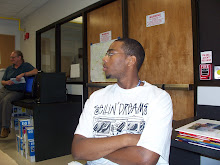Friday, July 17, 2009
life after Hamm
Im a hammie!
Friday, July 10, 2009
After lunch
Cdr cont...
Thursday, July 9, 2009
After Hamm
pre-CDR corrections
Results from dan meeting
CDR
Friday, July 3, 2009
team organization issues
Monday, June 22, 2009
Project management discrepencies
p.s. I already have a program to write data to the EEPROM with a time stamp, and I have a separate program to read data from all or specific addresses in the EEPROM.
Weekend activities
Friday, June 19, 2009
Prototype testing

Professor Jim had us test the insulation of our prototype boxes using 2 double A batteries and i resistor as a heat source. We recorded the temp inside the box using our hobo. I wasn't satisfied with the heat produced by the battery and resistor alone so I did a little experimenting of my own.
-Above is a picture of my setup. I have a 9 volt battery being shorted to produce heat(wire going from positive to negative), a 1.5 volt battery connected to an inductor(producing heat as well), and i have the same 2 lithium AA batteries connected to a resistor.
The previous set up of 2 double A batteries and resistor only produced 76 degrees Fahrenheit of heat. The set up in the picture above produced an excess of 95 degrees Fahrenheit. With this informatin we are able to get an idea of what it would take to keep our box nice and toasty :)
Payload box prototyping

Wednesday, June 17, 2009
Project Management lecture
morning lecture
Friday, June 12, 2009
mini trouble shooting guide for balloonsat BASIC stamp EEPROM writing
week two, friday afternoon lecture
pressure sensor activity


june/6/2009 HAMM radio session
and testing parallel series. first we built parallel series by hooking up two resistors in parallel and measured their there resistances together, then separate.

afterwards Dana pulled out an oscillo scope to show us how alternate current can be graphed and displayed.
-To the right is the oscillo scope and professor JIM is demonstrating the uses of the scope and the processes involved with reading it.
Thursday, June 11, 2009
ADC time stamp and write to EEPROM


time stamps

Friday, June 5, 2009
june 5th baloonsat programming cont.
-above is a video of the program running on our balloonsat module, if you look closely you will see that when i press the button the light flash one at a time. When not pressed down the lights remain off.
Thursday, June 4, 2009
balloonsat module testing
Fun right?!
Pacer day 4

Monday, June 1, 2009
Pacer day 1 continued
First day of PACER 2009!
*sidenote*
-this is my first blog....ever!

